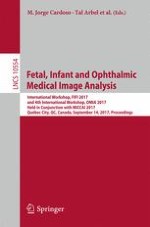2017 | Buch
Fetal, Infant and Ophthalmic Medical Image Analysis
International Workshop, FIFI 2017, and 4th International Workshop, OMIA 2017, Held in Conjunction with MICCAI 2017, Québec City, QC, Canada, September 14, Proceedings
herausgegeben von: M. Jorge Cardoso, Tal Arbel, Dr. Andrew Melbourne, Dr. Hrvoje Bogunovic, Pim Moeskops, Prof. Xinjian Chen, Ernst Schwartz, Mona Garvin, Emma Robinson, Emanuele Trucco, Michael Ebner, Dr. Yanwu Xu, Antonios Makropoulos, Adrien Desjardin, Tom Vercauteren
Verlag: Springer International Publishing
Buchreihe : Lecture Notes in Computer Science
